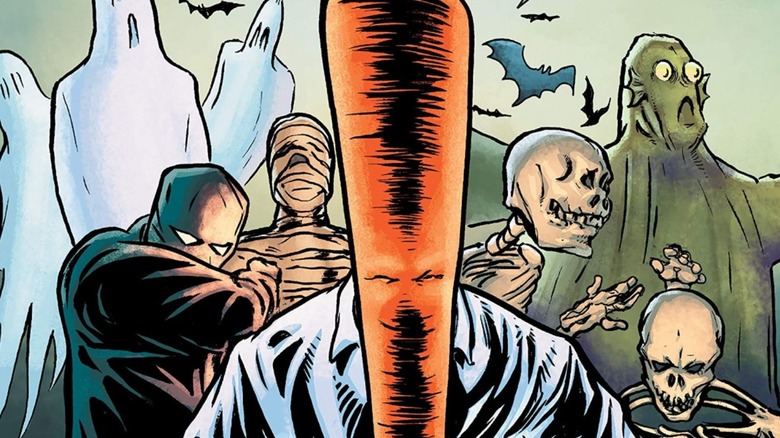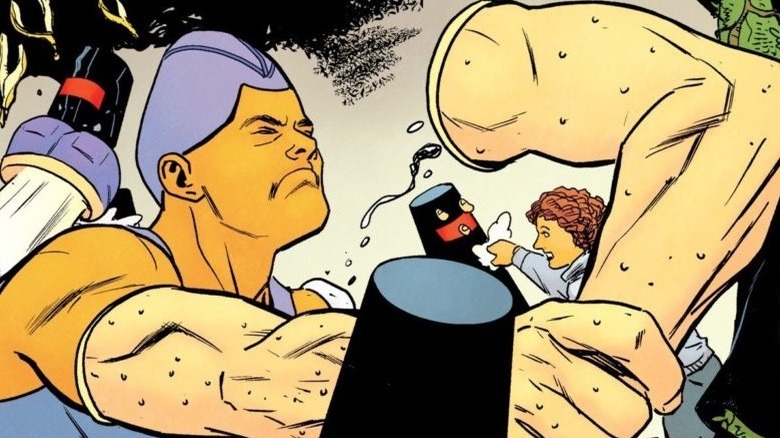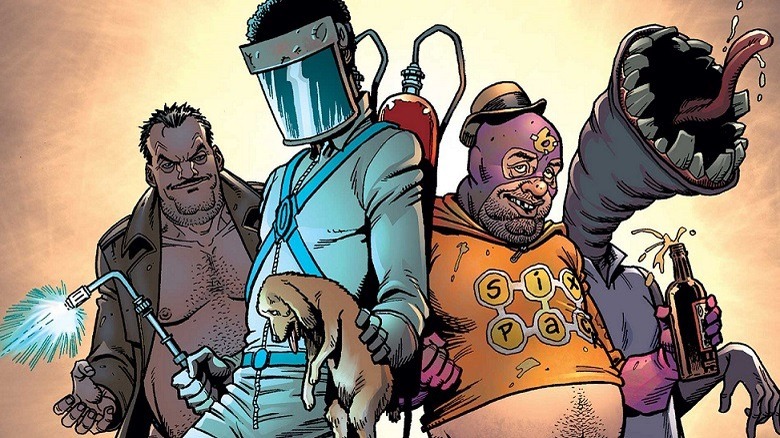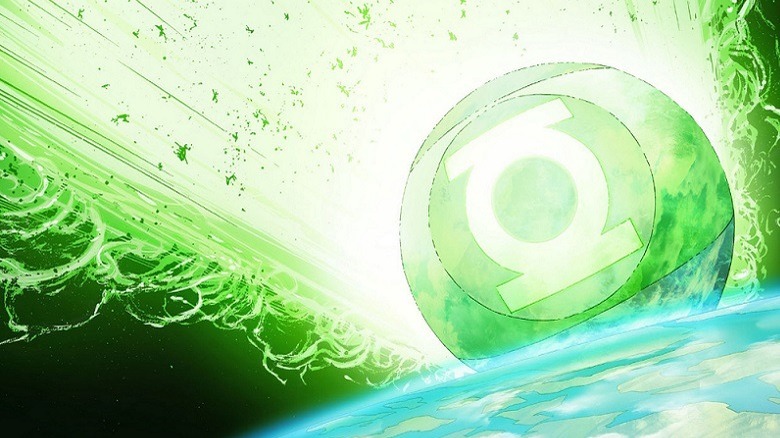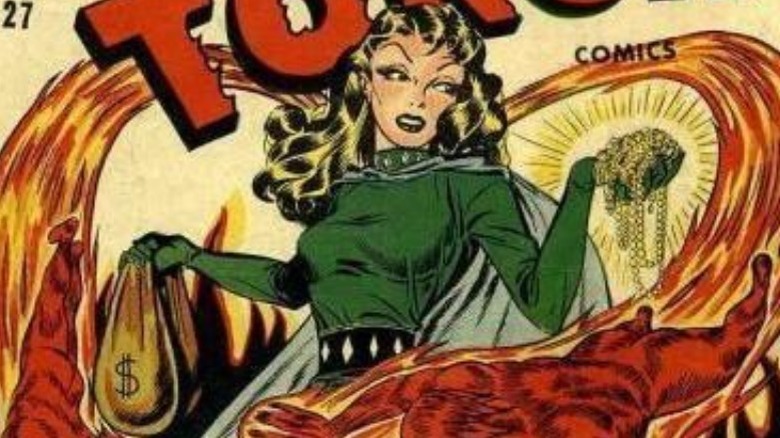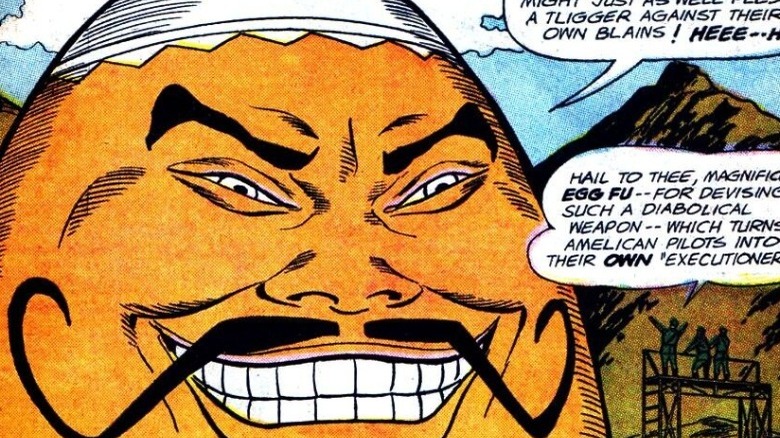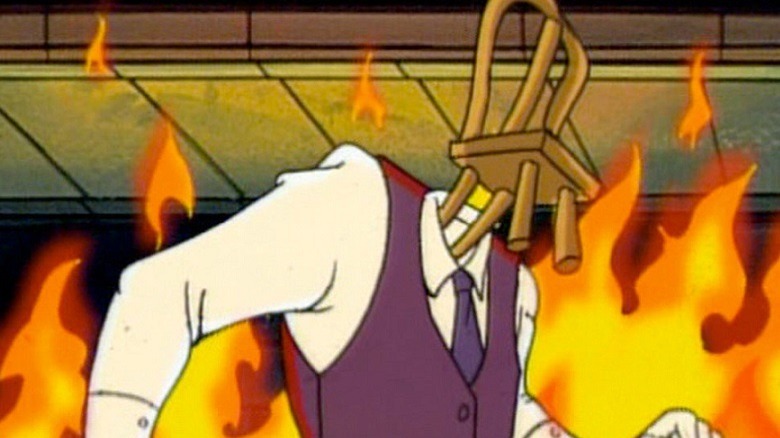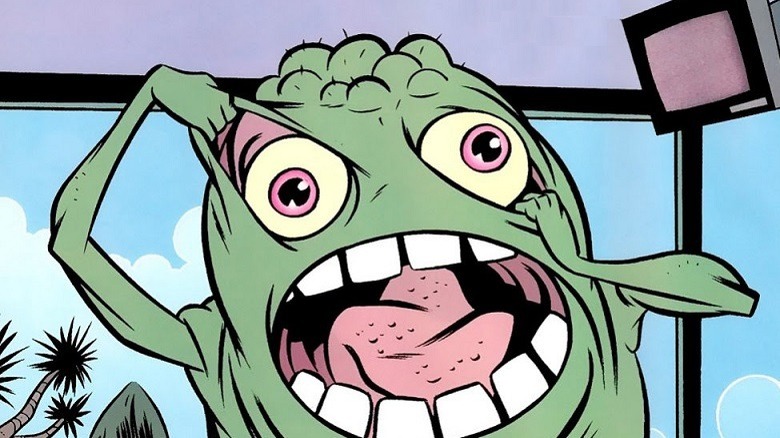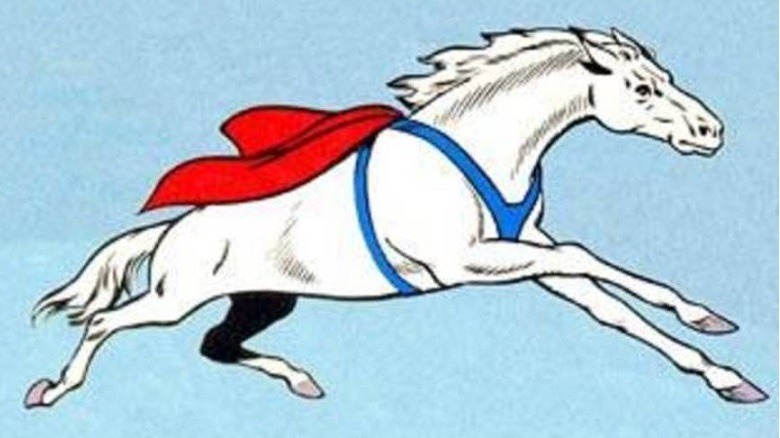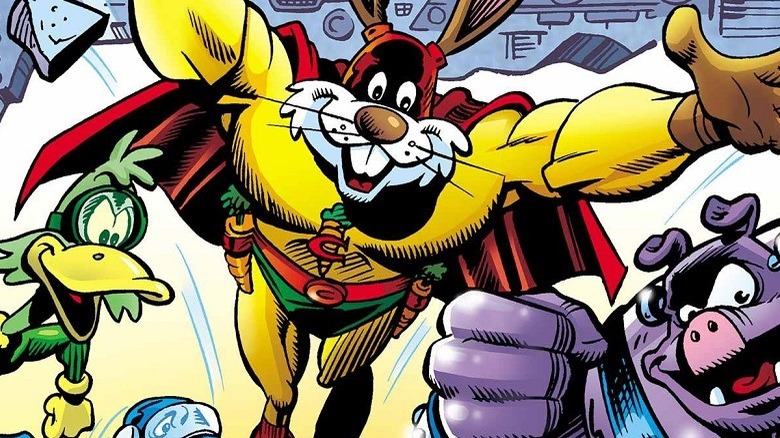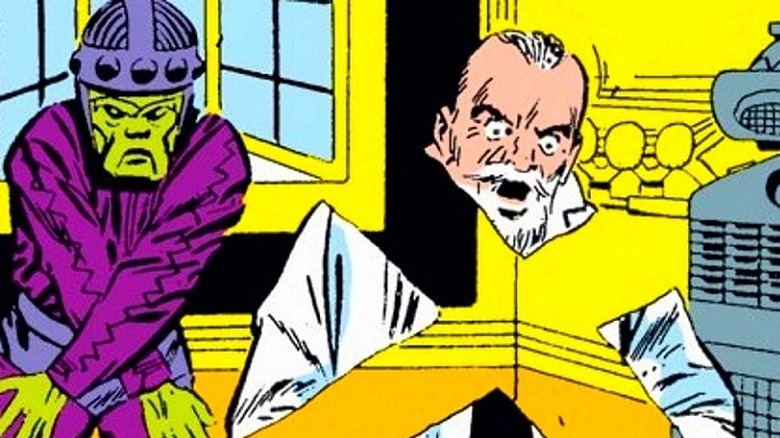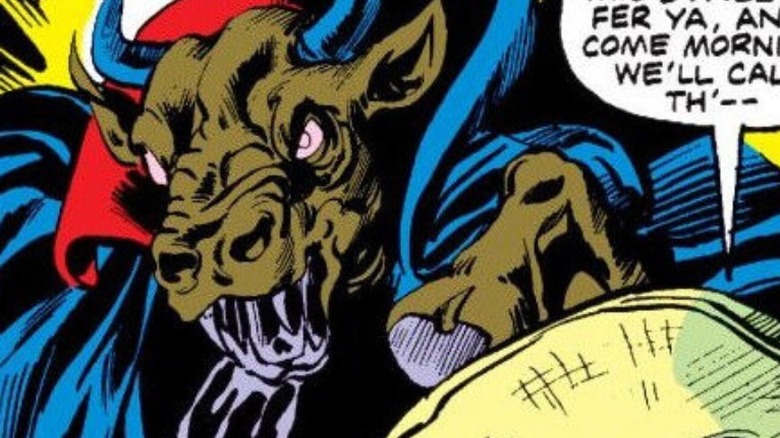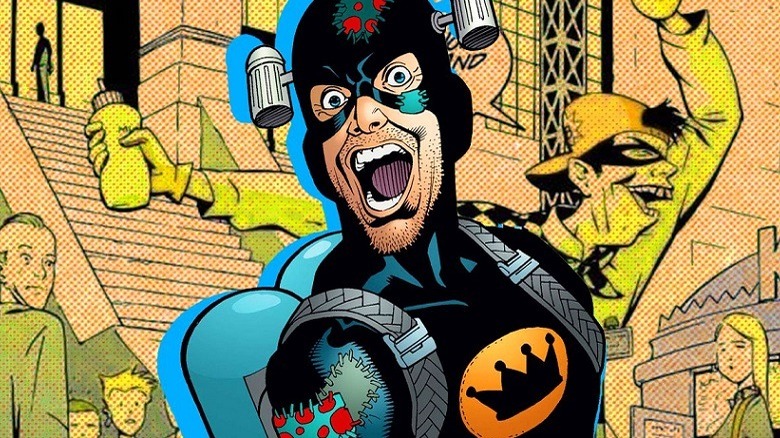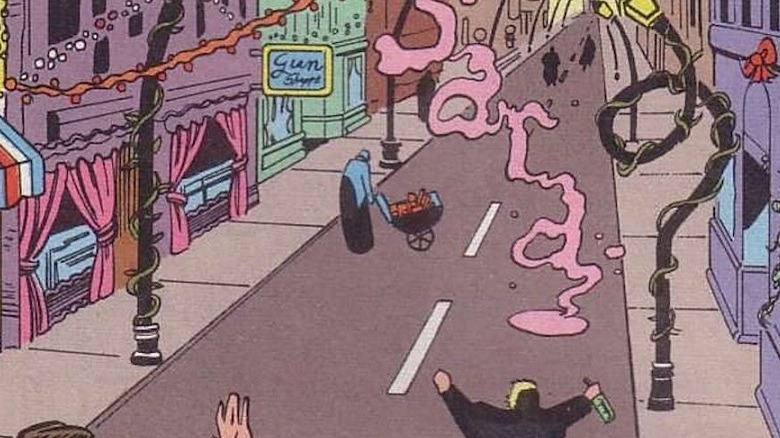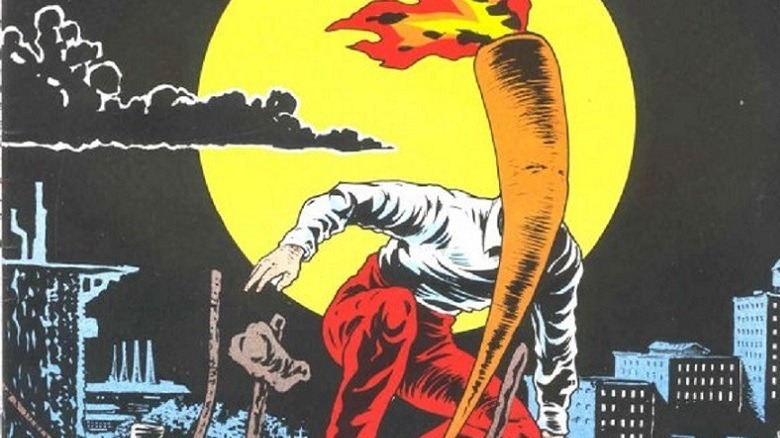The Strangest Comic Book Characters Of All Time
It's possible to suspend disbelief long enough to accept concepts such as a godlike alien who can fly and shoot heat rays from his eyes, a genius billionaire with Olympian strength and reflexes, and a living goddess of truth sculpted from clay. But to imagine that the aforementioned characters have pets that also team up together for crime-fighting adventures, that's stretching belief to Plastic Man levels. Yet, this motley menagerie (hitting the big screens as "DC League of Super-Pets") is far from the silliest or oddest characters to hit comic pages.
The Doors sang, "People are strange." It turns out that super-people can be, too. Some were clearly created to test credulity. Others are simply the product of a different era. However, the one thing the following all have in common is that they're just so weird. From characters that are best forgotten by history to those who have stood the test of time and are still going strong today, these are the strangest comic book characters of all time.
Arm-Fall-Off Boy
The 30th century's Legion of Super-Heroes has never believed in subtlety when it comes to the names of its members and hence the existence of Matter-Eater Lad (who eats matter), the Chlorophyll Kid (who can make plants grow quickly), and Porcupine Pete (who predates "Guardians of the Galaxy" by six years and can't justify his name as a weak Peter Quill pun).
Having both an awfully specific name and a singular power of arguable usefulness, Arm-Fall-Off Boy must have thought he was a shoo-in for Legion membership. Imagine his dismay upon failing the tryouts — the erstwhile League unable to see the benefit of fielding a man capable of ripping off his arm and using it as a blunt weapon. First appearing in 1989's "Secret Origins" #46, he's not to be confused with TDK (The Detachable Kid), the similarly powered superhero played by Nathan Fillion in 2021's "TSS" who was gunned down on a beach by Corto Maltese soldiers — an especially cruel fate since the hapless hero was unarmed.
Dogwelder
Created by the late Steve Dillon (best known for his work on Vertigo's "Preacher"), Dogwelder was introduced in issue #18 of the Garth Ennis-John McCrae comic "Hitman".
A member of the incompetent and ill-fated superhero team Section 8 (named after the military phrase for discharging somebody due to mental illness) Dogwelder had no powers per se, but he did have a unique penchant for welding dead dogs to criminals. The original character was little more than a throwaway gag — an opportunity to create the stupidest comic book character ever. Much like the other members of his squad (including The Defenestrator, Friendly Fire, and FlemGem), he perished in battle.
However, Section 8 leader SixPack survived and formed a new superteam, recruiting a new Dogwelder. The dubious title wound up having a legacy with the new incarnation being the last in a long line of Dogwelders. Despite his origin tale involving John Constantine of "Hellblazer" fame, the character was far from serious. Still, it seems appropriate that the last work that creator Dillon worked on before his death in 2016 were covers for the "Six Pack and Dogwelder: Hard Travelin Heroz" series.
Writer-director James Gunn considered adding the character 2021's "TSS," but as an animal lover, he decided that the character might not be suitable for the big screen.
Mogo
Mogo is one of the few members of the Green Lantern Corps allowed to operate naked — primarily because of the sheer amount of fabric it would take to clothe a sentient planet. However, he is capable of maintaining his modesty with some handily arranged foliage and a discreet cumulonimbus or two.
Created by the British Invasion creative pair of writer Alan Moore and artist Dave Gibbons, this pistachio-hued planetoid's first appearance was in "Green Lantern" #188 in 1985. In it, Bolphunga the Unrelenting — dreaded prize-fighter and bane of spellcheckers — arrived on Mogo's surface. Seeking out the fabled Mogo, he was blissfully unaware that the planet he spent years searching was actually his quarry. Bolphunga's eventual realization caused the puce pugilist to flee, having finally met his match.
Mogo's gravitational field is capable of ripping other planets apart. So if you arrange a meeting, it's probably best to visit him rather than wait for him to visit you. Ultimately, Mogo is the only Green Lantern who can prompt a cry of "That's no moon! It's a living planet who just happens to be a member of a notorious and well-renowned intergalactic law enforcement agency."
Asbestos Lady
Victoria Murdock was Asbestos Lady, a Marvel villain introduced in issue #27 of "Human Torch" back in 1947. Using the flame-retardant qualities of her asbestos-lined costume, she was a constant thorn in the side of the conflagrant crime-fighter. Sadly, her criminal genius didn't extend to predicting the carcinogenic qualities of the very material she wore. She is, however, one of the few villains for whom the EPA Clean Air Act of 1970 was as much of a nemesis as any superhero.
Although it's easy to see the benefits of a villain having a costume that makes superheroes not want to go anywhere near her for fear of developing mesothelioma or asbestosis in later life, it's just not sustainable for an ongoing career in crime. Presumably wishing she'd gone with her first choices of having a costume made entirely out of poison or razor blades, Victoria met a grisly end. She died at the age of 45 from cancer — a fate presumably related to her ill-fated sartorial choices.
Egg Fu
Introduced in "Wonder Woman" #157 in 1965, this supervillain with a name presumably inspired by the popular Chinese dish egg foo young is nothing if not memorable — for all the wrong reasons. A giant, yellow communist egg, this horrendous racial stereotype would go on to fight Diana and Steve Trevor with both his criminal genius and his whip-like mustache. A textbook example of yellow peril, a racist fear of people of East Asian descent that took hold in the West beginning in the 19th century, Egg Fu was as offensive as could be, drawing on every stereotype possible. Imagine a massively xenophobic Humpty Dumpty, and you are halfway to imagining this bizarre, eggy archaism.
Luckily, somebody at DC decided that un oeuf was un oeuf, and this racially-insensitive version of Egg Fu was mercifully erased from continuity during "Crisis on Infinite Earths." The character's redesign (he's now a smaller and considerably less xenophobic ovoid with mechanized spider-legs) is equally as odd but immeasurably less culturally offensive.
Chairface Chippendale
There are enough oddball evil-doers in "The Tick" (Dinosaur Neil, Eastern Bloc Robot Cowboy, Barry Hubris) to support an entire article on strange comic book characters. Yet, none are as outlandish as Chairface Chippendale.
Possessing an antique Rococo-style chair for a head, Chairface Chippendale (the father of Stoolface Chippendale, whose appearance you can probably figure out yourself) is an egotistical and wily criminal mastermind eager to make everybody on the planet know his name. First appearing in issue #7 of "The Tick" comic ("The Moon Menace"), little is known of the throne-faced thief's origins (other than his resentment over his appearance), but his nefariousness is made clear from the start when he attempts to carve his name onto the moon.
Unable to take this sitting down, The Tick defeats the furniture-faced felon mid-villainy, leaving only the letters "C," "H," and "A" on the lunar surface as a permanent memorial to Chippendale's ineptitude.
Doop
On ranked lists of characters in the Marvel universe, the same old familiar faces regularly appear: Galactus, The Living Tribunal, Zeus. Yet, one particular green potato-shaped entity is conspicuous by his absence. He may resemble Slimer's uglier cousin, but you'd be wise to give him some respect.
Of course, I speak of Doop — the official videographer of X-Force introduced in "X-Force" #116. Created by writer Peter Milligan and artist Michael Allred, this pear-colored polymath is an enigma. His origins are shrouded in mystery, and he possesses a bewildering array of powers.
Whether he hails from Marginalia (the fourth-wall-breaking reality that exists beyond the margins of comics) or, as posited by Captain America, he's the result of a cold war experiment, Doop is quite unique. Speaking in his own unique language (yet oddly understood by all), he's omniscient and capable of time travel, resurrection, and wielding (or rather swallowing) Thor's hammer Mjolnir.
When entropy claims the universe, and nothing remains except an empty colorless void, a triumphant Doop will be there — doing something weird.
Comet the Super-Horse
Is it a bird? Is it a plane? No! it's a horse!
Sadly missing from the roster of audacious animals in the forthcoming "DC League of Super-Pets" is Comet the Super-Horse (unless he features in an uncredited cameo as an ingredient in Krypto's dogfood). First appearing in "Action Comics" #293 in 1962, the super-stallion would go on to be the favored pet of that era's Supergirl, joining that pantheon of famous equines that includes Mr. Ed, Trigger, and that severed horse head from "The Godfather."
Along with super-speed and strength, flight, telepathy, and the ability to detect sugar cubes in people's pockets from twenty paces, Comet is also capable of shape-shifting, morphing into rodeo rider "Bronco" Bill Starr, who in human form, romanced both Supergirl and Lois Lane. Yeah, let's not go there. It was a more innocent age.
Wiped from continuity in 1986 (like the rest of the League of Super-Pets), Comet would later reappear in the pages of "Supergirl" in issue #14 in 1997. If anything, the revival was even odder. This Comet was a shapeshifting centaur.
Captain Carrot and the Zoo Crew
Captain Carrot is the stalwart leader of the Amazing Zoo Crew, a team of super-powered anthropomorphic animals. First appearing in the pages of "New Teen Titans" #16 in 1982, Carrot and his marvelous menagerie hail from the alternate reality of Earth-35.
When not out saving the world, Carrot's alter-ego is that of Rodney Rabbit (changed from Roger to avoid copyright infringement), mild-mannered cartoonist. Reaffirming that vegetables are indeed good for you, Carrot gained his unearthly powers by eating a cosmic carrot that embued him with flight, invulnerability, super-speed, and, if the rumors are to be believed, the ability to see in the dark.
Despite the absurd nature of Carrot and his team, they've crossed over into the main DC universe on more than one occasion, resurrected for the final conflict against evil Mandrakk in Grant Morrison's "Final Crisis" storyline in 2008 and also in his reality-spanning epic "Multiversity".
The Living Eraser
The Living Eraser hails from Dimension Z (Dimensions A through Y having already been taken), and with just a swipe of his green hands, he can erase his victims, wiping them out with bold strokes. The first time he appeared on the comic scene (in 1963's issue #49 of "Tales to Astonish") was to do just that — erasing experts in the field of atomic energy.
However, the reality of his powers is somewhat less creepy and more mundane. Rather than being erased, his victims are transported to Dimension Z. It just so happens that Dimension Z shares the same space as Earth, and its ghoulish green inhabitants have been observing us for some time, eager to steal our technology so they can create their atomic bomb. I'm no megalomaniacal alien leader, but I can't help but feel that having conquered inter-dimension travel, atomic bombs should have been no trouble.
The character has continued to appear irregularly over the decades, presumably still struggling to conquer atomic power (or perhaps seeking to add correction fluid to his list of powers). Nonetheless, history refuses to erase The Living Eraser!
Hellcow
Cows have a hard time in the Marvel Universe, and Hellcow's sad plight is no exception. Left for dead after being drained of blood by the notorious vampire Dracula in Switzerland in the late 17th century, Bessie the Cow soon rose from the makeshift grave fashioned by her heartbroken owner Hans. Quite perturbed to find herself undead, she began a quest to find the fiend who did this to her. This hunt (and the relentless bloodlust that comes with her curse) has caused her to cross paths with a number of superheroes, notably Howard the Duck and Deadpool.
First appearing in 1975's "Giant-Size Man-Thing" #5, this blasphemous bovine has the standard list of abilities common to vampires: immortality, super-human(or rather super-bovine) strength, and flight — with the added advantage over other Nosferatu of being able to produce delicious milk.
At this stage, a crossover with Blade is, I believe, unlikely.
Condiment King
A "sauce" of constant bemusement to Batman, Condiment King (introduced in the 1994 "Batman: The Animated Series" episode "Make 'Em Laugh") is a crook who uses an arsenal of condiment-related weaponry to achieve his fiendish aims. Barely cutting the mustard in comparison to the other villains in Batman's extensive rogue's gallery, this deliberately jokey character eventually made it into the comics, sparring with Blue Beetle, Robin, Black Canary, and Batgirl whom he fought with great relish but to negligible effect.
Robin, exhibiting some of the detective skills of his caped mentor, deduced that the greatest threat that Condiment King posed to the general public was through allergies. Exposure to freshly-shot mayonnaise is no laughing matter for somebody allergic to eggs.
However, Condiment King would not prove to be a long-lasting threat. He was eventually betrayed by his villainous community during the events of "Final Crisis" and beaten to death with his ketchup and mustard guns.
Danny the Street
One would be hard-pressed to find any characters from Grant Morrison's 1989 run on "Doom Patrol" veering anywhere near the direction of normality, but Danny the Street is a particular standout.
A sentient street and a permanent home to outsiders and the lost (much like the fabled Midian from of Clive Barker's "Nightbreed"), Danny can appear anywhere. The geography of any landscape will adapt to accommodate them, warping reality and memories to make it seem as though they were always there. Incidentally, the name is a tribute to and pun on legendary Irish drag Queen Danny La Rue — "La Rue" being French for "the street." Danny the Street has no definite origin. They were never human, and the name Danny was given to them.
It's a concept that translated well into live-action, featuring in multiple seasons of the "Doom Patrol" TV show. Danny the Street is Morrison's attempt at depicting a gender-queer character from a new, respectful, and interesting perspective. In the comics, Danny the Street is bristling with "masculine" buildings such as army surplus stores and gun shops. However, each is decorated with garish accouterments, fairy lights, and blooming flowers.
The Flaming Carrot
Bob Burden's surreal, Eisner Award-winning "Flaming Carrot Comics" is the perfect home for oddballs and misfits. Indeed, the title's superhero team was previously featured to profound effect in their own film, 1999's superlative "Mystery Men." The title character, however, is the standout. His true identity is never revealed. All we know about the character is that he gained his powers after reading 5,000 comics on a bet. He suffered brain damage and became The Flaming Carrot.
As with the new wave that was sweeping music in the early '80s, 1981's "The Flaming Carrot" is the product of an era that saw a great level of innovation and productivity from independent artists and writers operating outside the big two of Marvel and DC who brought a punk rock sensibility to comics. It was an era that, unconfined by traditional publishing rules, saw great experimentation, leading to works such as Kevin Eastman's "Teenage Mutant Ninja Turtles," Dave Sims' "Cerebus the Aardvark," and Burden's "The Flaming Carrot."
The Golden Age of Comics is traditionally accepted as taking place between the end of the thirties through the mid-1950s. However, a new golden age of independent comics was happening in the late 1970s through the '80s, and the anarchism and joy of "The Flaming Carrot" is a direct result of that.
